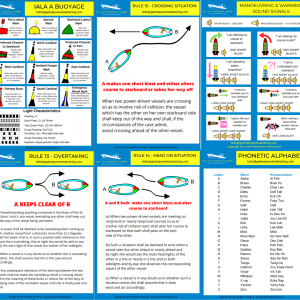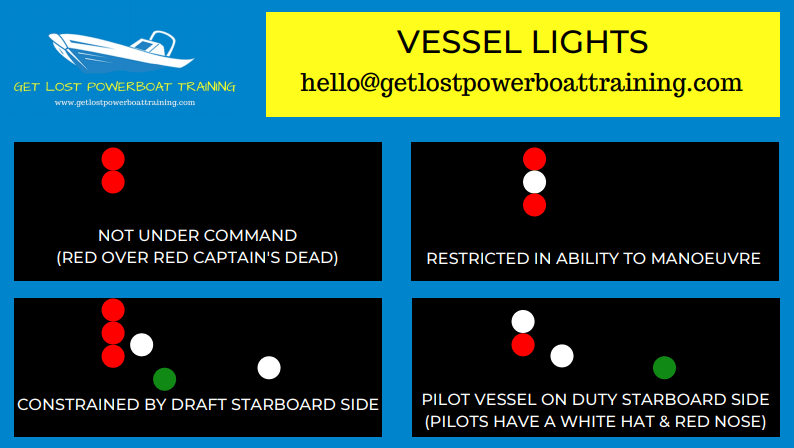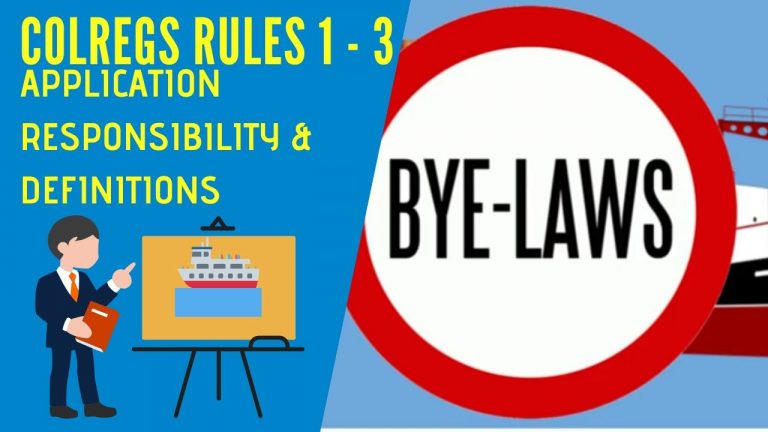When we start taking our boats out we eventually get to the stage where we go out in the dark. That means we are going to see some different vessel lights on the water.
This may even come sooner than we intended if we get our planning wrong and arrive late.
There are lots of lights out there to try and make sense of. It’s important that we can identify some of the signals we are being shown so that we can avoid any dangers. This could include large shipping, boats with fishing gear or even military vessels.
Below is a complete guide to vessel lights along with another of our handy downloads. There is a load more information on our YouTube channel too, which you can find here:
Don’t forget to Subscribe ?
First of all take a look at this video guide to the definitions of vessel lights and their visible angles.
POWER DRIVEN VESSELS
Normal power driven vessels have four lights to distinguish them from other boats.
As per all other boats they have a red port light on the left side of the bow. Opposite that they have a green starboard light on the right side of the bow. In the below image we can see that the vessel is facing us.This is because we can see both the port and starboard lights at the same time.
As well as these two lights, power driven vessels have a forward facing, white masthead light. This indicates that the vessel is being propelled by machinery. This light is sometimes referred to as a ‘steaming light’ because of this.

A second piece of information we can derive from the masthead light is it’s size. A vessel with a single masthead light is under 50 metres in length. A second masthead light is compulsory for vessels over 50 metres in length. Just like in the image below.

The reason we state that two mast head lights ‘probably’ mean over 50 metres is because smaller vessels are also allowed two masthead lights. However, this is usually impractical because the rules state that the second masthead light must be 4.5 metres higher than the first. Most smaller vessels don’t have the structure to accommodate this.
Finally, a power driven vessel has a single white stern light. When this light is visible to us, we can’t see any of the bow or steaming lights. We therefore know we are approaching the vessel stern. This is important as under the IRPCS (or ColRegs) this makes us the overtaking vessel and therefore the ‘Give Way’ vessel.
There are a couple of exceptions to the above light configuration for power driven vessels.
Firstly, a vessel of less than 12 metres in length is allowed to combine the masthead light and stern light. These then become a single all round white light.
Secondly, a power driven vessel of less than 7 metres in length and capable of a maximum speed that is less than 7 knots, is allowed to display a single all round white light in lieu of everything else.
AIR-CUSHIONED VESSELS OR HOVERCRAFT
These vessels are power driven and so they display the same lights as power driven vessels. In addition however, so they can be distinguished, they also display and all round flashing yellow light. This is mounted where it can best be seen.

SAILING VESSELS
The lights for sailing vessels are very similar to those of power driven vessels plus a couple of extra options.
When sailing, the vessel has to display red and green side lights and a white stern light. It does not display a forward facing masthead light as that would mean it was being propelled by machinery. A masthead does need to be fitted though as it must be displayed when the engine is turned on. This is an important distinction because sailing vessels and power driven vessels avoid collisions in different ways.

We can also tell something about the vessel size from the two side lights. Smaller sailing vessels, under 20 metres in length are allowed to combine the two lights at the top of the mast. Once a sailing vessel is over 20 metres long then the two lights must be separate. These then have to be placed on the bow.

Additionally, sailing vessels have the option to show two all round lights at the top of the mast. These are a red light over a green light. However, these can’t be shown at the same time as a combined light mentioned above.
Finally, much like power driven vessels, a sailing vessel less than 7 metres in length is able to display a single white light instead of the other lights.
so those are the basics for power driven vessels and sailing vessels. There next comes a series of vessel lights that indicate special conditions. These help us identify the ‘Give Way’ and ‘Stand On’ vessels that are described under Rule 18 of the IRPCS. Rule 18 is the responsibilities between vessels and you can get a reminder of this rule using the following video.
All of the following vessels are identified by different day shapes during daylight hours. If you need a recap on these check out this article:
VESSELS NOT UNDER COMMAND
Vessels not under command identify themselves by showing two all round red lights, one above the other.
‘Red over red. Captain’s dead.’ ?
They come at the top of the ‘Stand On’ list because they can’t effectively take action to avoid a collision. This is defined as being due to an exceptional circumstance. For instance, they are broken in some way or have sustained damage that compromises their ability.

Importantly, these vessels give us some other information. If they are making way through the water then they display their side lights and stern light. If they are not making way through the water then they only display the all round red lights to indicate that they are not moving.
Additionally to the above, if the exceptional circumstance is because the vessel is aground the anchor lights will be displayed as well.

RESTRICTED IN ABILITY TO MANOEUVRE
In equal place in the ‘Stand On’ list are vessels restricted in ability to manoeuvre. Unlike vessels that are not under command, these are not restricted due to an exceptional circumstance. Instead, these are restricted due to the nature of their work. They could be carrying out under water surveys, diving operations, laying pipes or cable or anything else that hampers them.
These vessels are distinguished by three all round lights in a vertical line. The middle one being white and the other two being red.

This is a second vessel that will turn off its side lights and stern light if it not making way through the water. It will turn them back on again once it starts making way.
One such vessel mentioned under this rule that is restricted due to the nature of its work is a Mine Sweeping vessel.

These vessels display the lights for a power driven vessel appropriate to their size plus three all round green lights arranged as shown. I would suggest that if you ever see these lights you’re in the wrong place.
VESSELS CONSTRAINED BY DRAUGHT
A vessel constrained by it’s draught can only navigate within the confines of a narrow channel. The draught is the distance from the waterline to the bottom of the hull or keel. In this case the vessel requires deep water so as not to run aground. Smaller vessels must not impede these larger ships.

To show their condition these vessels display three all round red lights in a vertical line. Unlike previous examples though, these vessels never turn off their side lights or stern light.
VESSELS ENGAGED IN FISHING
The next vessels in the list are those engaged in fishing. These guys are hampered by their fishing gear and represent quite a hazard to recreational boat users. There are different types of fishing activity and they are distinctive by use of their lights.
Fishing vessels also turn off their side lights and stern light when they aren’t making way.
Vessels engaged in standard fishing will display a red light over a white light to indicate what they are doing.
‘Red over white frying tonight’. ?

Vessels engaged in trawling instead of normal fishing will indicate the fact by displaying a green light over a white light. This lets us know that there fishing nets extending from the vessel which will present a hazard to other boats.

Sometimes trawlers will work together. This is referred to as pair trawling. Both trawlers will display green lights over white lights. Additionally, they will display different lights to illustrate their activities. These are as shown in the following three illustrations.



The final type of fishing vessel with a unique light display is a Purse Seine fishing vessel. These fisherman drop weighted nets in a circle so as to form a ‘purse’. These are then drawn in like a big bag to collect the shoals of fish.

In addition to the red over white lights, purse seiners will display to flashing yellow lights. These are installed vertically and flash alternately.
VESSELS ENGAGED IN TOWING AND PUSHING
Vessels engaged in towing and whose purpose is to be able to tow will display the lights for a power driven vessel. In addition, they will display a second, white, forward facing masthead light and a yellow stern light. The yellow stern light is placed above the usual white stern light.

The length of the tow is measured from the bow of the towing vessel to the stern of the tow. If this total length exceeds 200 metres then a third white, forward facing masthead light is displayed.

On occasion, rather than towing behind, it is necessary to push another vessel ahead. In these circumstances the towing vessel displays the same lights as above. However, the vessel being pushed will also display its own side lights. This is shown in the below starboard side illustration.

TOWING PARTIALLY SUBMERGED OBJECTS
When towing partially submerged objects such as pontoons or salvaged vessels, the towing lights remain the same. In addition to these, the objects have required light configurations as well.
A partially submerged object must have a white all round light installed on the front end and the back end.

If the object is over 100 metres in length then additional all round white lights must be installed so that the space between them does not exceed 100 metres.

If the object is more than 25 metres wide, then all round white lights must be installed on the sides of it. These are in addition to the other white lights described here.
PILOT VESSELS ON DUTY

A pilot vessel on duty will display an all round white light over an all round red light. This indicates to us that there is a large ship in the vicinity and we will be required to stay out the way.
‘Pilots have a white hat and a red nose’. ?
Free Download
All our images are put together in a free cheat sheet that you can download by clicking HERE.
Our complete set of Knowledge Cards are available from our shop
-
 Skippers Knowledge Cards£19.99
Skippers Knowledge Cards£19.99


